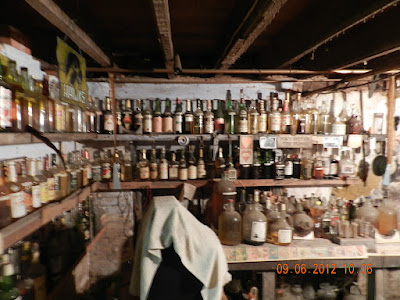Amana RV Park
Amana, IA
Amana is a tourist town with lots of history. We opted to take a three hour tour and was lucky enough to have Tom as our tour guide.
Amana lies in a very fertile valley, a little southwest of Cedar Rapids, on both sides of the Iowa River. Go to http://amanacolonies.com/ for an excellent travel guide that you can view online. I would never be able to describe the history and do it justice in a post.
They built a canal at one end of the colonies off the Iowa River and after it went through the town and turned the water mill the water went back into the River. There has been so little raid that the canal had more water in it that the river because the canal is lower.
Looking one way out the window at the canal......
Looking the other way through the window as the canal heads towards a
dam and flour and woolen mill.
dam and flour and woolen mill.
This is a typical Amana house, John Metz a tinsmith lives here.
This was his parents house and where he was born 83 years ago and still lives here.
John's late wife made this, he said it's too complicated to take down and put away
so he just keeps it up, lucky for us.
These two chairs were made at the village furniture shop and given to John's parents when they were married. The people in the Amana society back then lived in a communal society, they had no money they were given everything they needed. They were assigned jobs as to what they were suited for, no money was exchanged.
Johns mother made this quilt. Notice it is not pieced together but hand sewn in the pattern
Below are several quilting templetes.
This is the one that was used on the above spread
This is a quilting table that John's mother used
Picture of John's mother and aunt quilting
John's tinsmith shop was in the basement. This is a cake pan called "round star" and used for weddings or other special occasions and festivities.
Unfortunately he does not sell anything here, he only makes special order now and then. Remember he is 83.
His father's man cave. This room has not been touched in 20 years and John has left it just the same. Many times men would gather to discuss whatever is was that these men discussed, and they would bring their choice of adult beverages put their name on the bottle and then leave it until next time. This room was probably started back in the early 1900's
A typical window in the houses were called simply 9 over 6 and usually for the downstairs,
the upstairs had 6 over 6 windows
(do you get it, 9 panes over 6 panes)
Our tour group standing outside one of the communal kitchens.
The women would often come outside to work and gossip.
Notice the bench on the left.
Bench on the left
Picture of the women working outside the kitchen siting on that bench. Notice they have something on their laps, its a cutting board with sides on it to keep from loosing anything
Two of the cutting boards along with other tools they used
Kitchen, in the middle is the wood burning oven/stove.
The pan in the very front on the stove is a waffle iron.
A list of the different communal kitchens and how many people they were serving for each meal. They were given three meals a day plus two snacks. The snacks were a small mini meal.
This a modern kitchen as it had running water for the kitchen.
This is a slanted board and called a "dry sink"
The oven
This large board was used for cutting noodles
It's a bread cutter
A potato ricer
The year above the name is 1887
The post office inside the store. Sort of like Little House on the Prairie
Inside the church. Men sat entered from the door on the far side and then sat on the far side and women then came in on this side and sat on this side. They went to church many times every day. These benches are from the mid 1850s
Just a close up of how they are held together
This is a picture of the floor in the middle of the church. They use a variety of hard woods and not painted or varnished. It's got a whitish glow to it because the benches and floor are scrubbed weekly with lye. They just take a bucket of a misture of water and lye and throw it out and everything gets wet. Note the small square in the wood plank, that is a drain. So they just lift that piece of wood and the water and lye are swept down the drain.
Looking towards the front of the church, six elders sit on the benches but only one speaks.
The person giving us the history lesson is Tom our tour guide.
That's enough of the tour, tomorrow we visit the town and do the touristy thing and visit all the shops.
Thanks for stopping by, have a blessed day
Nancy



































No comments:
Post a Comment